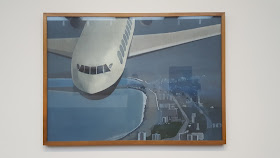"To be released and unselfconscious - how wonderful that would be" - Michael Andrews.
Michael Andrews (1928-1995) disdained publicity throughout his life. The Gagosian gallery's current Earth Air Water retrospective is the first substantial exhibition of his works in fifteen years. He was a contemporary of Lucian Freud, Francis Bacon, Frank Auerbach, and Leon Kossoff and while his name may not be as well known as those artists that's no reflection on his ability as a painter.
Born in Norwich he studied at the Slade in UCL before going on to teach at the Chelsea School of Art. Whereas Freud and Bacon distorted the human form and painted psychological portraits Andrews rarely depicted people. Human presence is often implied, suggested rather than depicted.
Someone's flying the plane in 1975's Cabin and someone's in that hot air balloon in the previous year's Lights VII:A Shadow. In the 50s Andrew had painted bohemian scenes from Soho drinking clubs but in the last two and a half decades of his life he preoccupied himself with four series of landscapes - Lights, Scotland, Ayers Rock/Australia, and English Landscapes. It seemed like he'd had enough of the self-indulgences and bad living of the capital and wanted to get some fresh air and a clear mind. He claimed, somewhat pompously, influence from Rimbaud, RD Laing, and Zen Buddhism and said the balloon, a recurring motif in his work, represented a symbol of the ego encased in a bag of skin in search of a landing place as a quest for unselfconsciousness.
Equally self-importantly he said, in 1986, "it seems to me impossible not to paint religious landscapes of aboriginal Australia". Not totally sure about that but the Australian portraits do particularly reflect that kind of dreamy logic. They border on pastiche but never quite cross that line. Andrews' style owes a lot to his use of watery acrylic paint and a spray gun to apply it. ".
There's a small selection of his portraits, including 1988's Self-Portrait (below), in the corridor before we're ushered into a large room containing some of his very best landscape painting. Laughter Uluru (Ayers Rock) - The Cathedral I (1985) and the two SAX A.D. paintings (1982 & 1983) show two very different sides to his style - and two very different terrains. The frontierland of Australia's outback looking comfortably alien and the green fields and weak blue skies of England looking almost disconcertingly familiar in contrast.
Some of his English rural idylls are almost hyperreal in their detail. Others, like the triptych Three Moments in a Stalk, Glenartney August 1982, are more idealised. The Thames at Low Tide (1993/4) borders on abstraction. I was asked by the invigilator not to take a photo of that one as it was in a private collection (which almost all of these are) but I'd taken it anyway so it's in the blog. I'm a maverick like that.
Alongside his hot air balloons, deer parks, ocean liners, and Brighton pier Andrews seemed to enjoy painting schools of fish. The School series (from the late 70s) includes some charming aquatic scenes as he further turned his gaze away from the cities and towards nature. It wasn't really the done thing at the time and this must've been part of the reason he remained in relative obscurity.
It seems to me that as a shy, taciturn man, though one prone to making rather grandiose statements about his oeuvre, he'd have been reasonably happy with that state of affairs. If he could work unhindered all the better for him and, as it turns out, all the better for us as we enjoy the fruits of the labour of this unshowy, yet highly talented, artist.











No comments:
Post a Comment